The Institute has approximately 40,000 rubbings of more than 28,000 bronze and stone items. Except for a few donations, most of these were purchased in the early 1920s. Among the Institute’s collection, many rubbings are not recorded in other sources; some of them were made at an early date or are of exceptional quality. Four themes are exhibited: “Full-surface Rubbings of Bronze Artifacts”chosen because of the fine technique of the rubbing, or because the typology of the original bronzes is not recorded in catalogues, or because of earlier scholars' writings on them. “Han Dynasty Rubbings” includes rubbings of illustrated carvings, bricks and tomb murals. “Buddhist Statues” presents mainly rubbings of Buddhist statues and other stone tablets in the Northern Wei dynasty (386-534); they express the characteristics of Buddhist belief at that time. “Funerary Inscriptions of the T’ang and Sung” shows the evolution of distinctive Chinese funerary culture during the T’ang and Sung periods (618-1127).
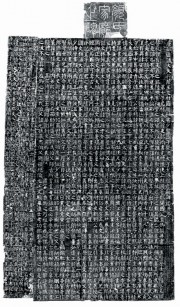
|
The Ancestral Temple Stele of the Yen Clan
Resource Identifier:01080-1 01080-2
Description:Made by Yen Chen-ch'ing for his father Yen Wei-chen, this stele describes the generations that preceded Yen Wei-chen, the family experience in government service, and the scholarship and career of Yen's offspring. Composed and written by Yen Chen-ch'ing at seventy-two years of age, this is a representative piece of Yen's calligraphy. As the tablet is inscribed on all four sides, it is also called a "four sided tablet."
Date:A.D.780,T'ang dynasty
Format:Gross height 274.0,gross width 154.0 cm.
Coverage:Excavated in Hsi-an,Shansi.The original stone is now kept in the Xi'an Forest of Stone Tablets Museum |
| |
|
| |
|
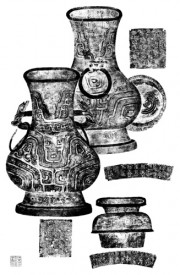
|
Yu Ssu K'ou Hu
Resource Identifier:186850
Subject & Keywords:FULL-SURFACE BRONZE RUBBINGS
Description:The body of the original vessel is lost. The lid is in the Palace Museum, Peking.
Date:Late Western Chou (mid 9th century-771 B.C.)
Format:Gross height 109.0,gross width 56.0 cm. |
| |
|
| |
|

|
King Father of the East, Disciples of Confucius and Chariots
Resource Identifier:12766-2
Subject & Keywords:HAN PICTORIAL RELIEFS
Description:The upper panel depicts the King Father of the East. Like the Queen Mother of the West, he was one of the highest immortals in the Han pantheon. In the middle panel are the disciples of Confucius among whom the one wearing a cockscomb is Tzu Lu. These Confucian figures reflect the ideological leanings of the tomb owner. In the lower panel are horses and chariots. They sometimes represent the inspection trips of the tomb owner, but can also depict funeral processions. The original stone is now kept in Chia-hsiang County, Shantung Province.
Date:Eastern Han (25-220 A.D.)
Format:Gross height 96.0,gross width 198.0 cm.
Coverage:Unearthed from the Wu shrines, Chia-hsiang, Shantung |
| |
|
| |
|
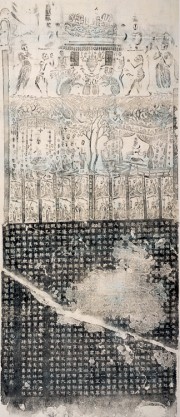
|
Inscription Recording the Erection of an Image by Hui-hsün and Hui-kang
Resource Identifier:10958
Subject & Keywords:BUDDHIST STATUARY STELES
Description:This stele was broken into two parts when stolen and moved from its original site. On the upper half appear three figures, Manjusri asking after Vimalakirti and devotees. On the lower half appears the inscription of the group of devotees that sponsored the stele. Beneath this is a scene from the life of Sudana, one of the former incarnations of the Buddha known for his charity. Buddhas are depicted on the back of the stele. The stele is now in the Metropolitan Museum of Art in New York.
Date:A.D.543 Northern Wei dynasty
Format:Gross height 267.0,gross width 115.0 cm.
Coverage:The original stone is now kept in the Metropolitan Museum of Art,New York. |
| |
|
| |
|

|
Epitaph for the Wet-nurse Jen
Resource Identifier:09924
Subject & Keywords:SUNG DYNASTY EPITAPHS
Description:This inscription was composed and handwritten by Su Tung-p'o. Wet-nurse Jen, the tomb occupant, foollowed her mistress into the Su family, where she got married and nursed Tung-p'o and his sister. She also attended to Tung-p'o's three sons and one grandson. This inscription enables historians to shift their focus from great men to ordinary people.
Date:A.D.1080,Northern Sung dynasty
Format:Gross height 89.5,gross width 64.0 cm.
Coverage:Excavated in Huang-Kang-hsien,Szechwan.The rubbing is based on a replica of the original stone made in the Ming dynasty. |
| |
|
| |
|
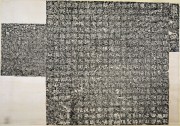
|
Hsi Hsia Message of Praise
Resource Identifier:00127
Description:This stele was erected on the plank road along a steep cliff of Mt. T'ien Ching, Ch'eng County, Kansu Province. The inscription includes the words "written by Ch'ou Ching of the style name Han-te." This is a rare case of mentioning the calligrapher's name in a Han stele. The characters on this stone tablet have been described as "stable like Mt. T'ai," and "like the flow of the Yellow River." Among Han dynasty clerical style calligraphy, they are closest to the standard style.
Date:A.D171,Eastern Han dynasty
Format:Gross height 148.5,gross width 215.0 cm.
Coverage:This stele was erected on the plank road along a steep cliff of Mt.
T'ien Ching,Ch'eng County, Kansu Province. |
| |
|
| |
|
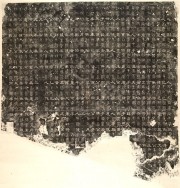
|
Rubbing of the Spring and Autumn Annals Carved on Steles during the Cheng-shih Era of the Wei Dynasty
Resource Identifier:186702
Description:Classics carved on early steles include the Book of History, the Spring and Autumn Annals and part of the Commentary on the Spring and Autumn Annals. Every word of the content was carved in three different calligraphy fonts: the archaic script, the seal script, and the clerical script. Thus the steles were also called “three-font stone classics”. Soon after the "stone classics" were carved, they were damaged or buried during a period of social and political turmoil and only began to re-emerge during the Ch'ing dynasty.
Date:A.D.241,Wei dynasty
Format:Gross height 144.0,gross width 103.0 cm.
Coverage:Excavated in Lo-yang,Honan |
| |
|
| |
|
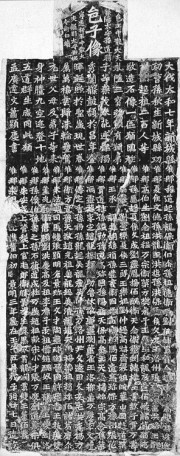
|
Inscription Recording the Erection of an Image in Ku-yang Cave at Lung-men by Sun Ch'iu-sheng, et al.
Resource Identifier:10529
Subject & Keywords:BUDDHIST STATUARY STELES
Description:This image was made by Sun Ch'iu-sheng and Liu Ch'i-tsu together with some two hundred others. They asked in return for this deed "manifold blessings in this life." The names of the man who composed the text and the calligrapher are also recorded. This piece is an example of an image sponsored by a Buddhist society.
Date:A.D.502,Northern Wei dynasty
Format:Gross height 131.5,gross width 49.5 cm.
Coverage:Excavated in Ku-yang cave,Lo-yang,Honan |
| |
|
| |
|

|
Inscription Recording the Erection of an Image of Sakyamuni in Ku-yang Cave at Lung-men by Wei Ling-ts'ang and Hsüeh Fa-shao
Resource Identifier:10574
Subject & Keywords:BUDDHIST STATUARY STELES
Description:This image of Sakyamuni was made by Wei Ling-ts'ang and Hsüeh Fa-shao. They asked that the merit for this act contribute to the continued success of the state and bring to all the "fruits of prosperity in this life."
Date:A.D.500-503,Northern Wei dynasty
Format:Gross height 90.5,gross width 36.5 cm.
Coverage:Excavated in Ku-yang cave,Lo-yang,Honan |
| |
|
| |
|
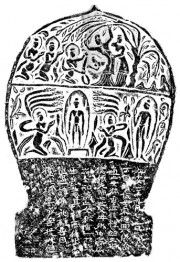
|
Image of Sakyamuni with Inscription Erected by Sung Te-hsing
Resource Identifier:10521
Subject & Keywords:BUDDHIST STATUARY STELES
Description:Sung Te-hsing erected this image of Sakyamuni for his deceased daughter, vowing that the merit from this act would allow her to be born in a pureland. Depicted are scenes from the life of the Buddha, including the birth of Sakyamuni, his declaration that he was foremost among all beings, and the water-libation given him by nine nagas. The image belongs to an early period of Chinese Buddhism centered on devotion to Sakyamuni.
Date:A.D.457,Northern Wei dynasty
Format:Gross height 43.5,gross width 30.5 cm. |
| |
|
| |
|

|
Epitaph of a Palace Lady of the Sixth Rank
Subject & Keywords:T'ANG DYNASTY EPITAPHS
Description:This is an epitaph of a palace lady. The characters are crooked and no name or location is given, reflecting her low social position. In the T'ang period there were two types of palace ladies: imperial consorts, and women involved in palace management.
Date:A.D.715,T'ang dynasty
Format:Gross height 30.5,gross width 30.5 cm. |
| |
|
| |
|

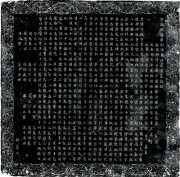
|
Epitaph of Fu Shou-ch'eng
Subject & Keywords:SUNG DYNASTY EPITAPHS
Description:This epitaph begins impressively with the six-generation pedigree of the tomb occupant, but ends pathetically with his lack of official success. He entered officialdom through his marriage into the imperial clan, without which he, like most of his peers, could probably not have afforded a resting-place. In lieu of pedigree as in previous times, career became the magnet for friendship and marriage during the Sung dynasty (960-1279).
Date:A.D.1105,Northern Sung dynasty
Coverage:Excavated in Lo-yang,Honan |
| |
|
| |
|

|
Ching K'o Assassinating the King of Ch'in
Resource Identifier:12766-11
Subject & Keywords:HAN PICTORIAL RELIEFS
Description:The upper panel depicts Ching K'o trying to assassinate the King of Ch'in. The image depicts the tense moment when the assassin Ching K'o threws a dagger which mistakenly hits the palace pillar, allowing the King of Ch'in to escape. The original stone is now kept in Chia-hsiang County, Shantung Province.
Date:Eastern Han (25-220 A.D.)
Format:Gross height 66.0,gross width 92.5 cm.
Coverage:Unearthed from the Wu shrines, Chia-hsiang, Shantung |
| |
|
| |
|

|
Salt Manufacturing
Resource Identifier:27004
Subject & Keywords:HAN PICTORIAL RELIEFS
Description:Since ancient times, Szechwan has been famous for its well salt. This picture clearly shows how Han dynasty Chinese dug wells in order to obtain underground salt and how they used bamboo tubes to transport the salt water to large cauldrons where it was boiled to obtain salt. The original brick is now kept at the Ch'ung-ch'ing City Museum in Szechwan.
Date:Eastern Han (25-220 A.D.)
Format:Gross height 42.0,gross width 52.0 cm.
Coverage:Unearthed from the Hua-p'ai Division, Ch'iung-lai, Szechwan |
| |
|
| |
|

|
Stone Gate Message of Praise
Description:These characters, carved on mountain rock, exhibit different sizes and styles. The vertical strokes in certain characters such as ming and sheng are especially long, a rare trait in the clerical-style characters of the Han dynasty. These characters are in fact described as a clerical-style that approaches running script. One critic remarked, "Because of their strong and forceful energy, the timid do not dare to imitate them and the weak cannot reproduce them." The original stone is now kept at the Han-chung City Museum in Shensi Province.
Date:A.D148,Eastern Han dynasty
Format:Gross height 207.5,gross width 99.5 cm. |
Text and images are provided by Institute of History and Philology, Academia Sinica
Digital Resources and Archived Images Application
|



























